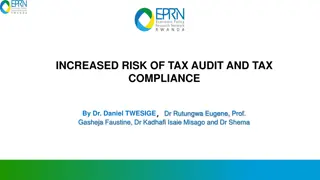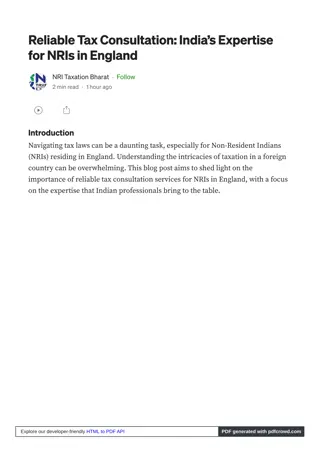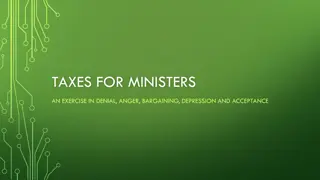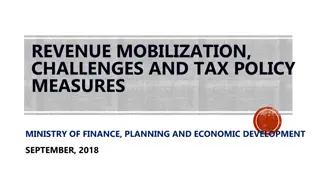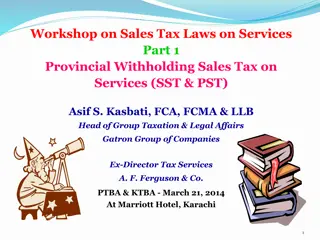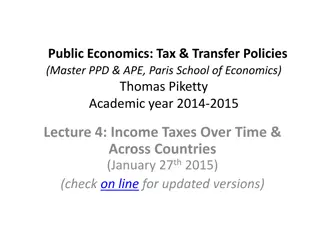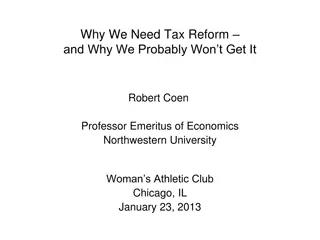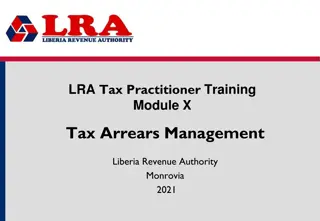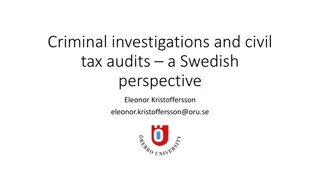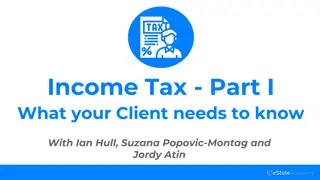Tax Rates and Economic Development - Seminar Insights
Exploring the impact of tax rates on economic development, this seminar delves into studies by Bania/Stone, Wong, and Haughwout et al. The discussion covers conceptual frameworks regarding profit maximization, capitalization, and the empirical importance of taxes on firms' decisions and economic development at the state and local levels.
Download Presentation

Please find below an Image/Link to download the presentation.
The content on the website is provided AS IS for your information and personal use only. It may not be sold, licensed, or shared on other websites without obtaining consent from the author. Download presentation by click this link. If you encounter any issues during the download, it is possible that the publisher has removed the file from their server.
E N D
Presentation Transcript
Public Finance Seminar Spring 2018, Professor Yinger Tax Rates and Economic Development
Tax Rates and Economic Development Class Outline Conceptual Frames Profit Maximization Capitalization Recent Research Bania/Stone Wong Haugwout et al.
Tax Rates and Economic Development Introduction Most state and local politicians run on the platform of jobs, jobs, jobs, and it is important to try to figure out what policies actually affect the number of jobs (and the incomes they generate) in a given jurisdiction. Today we are going to focus on the most basic question: Can a jurisdiction promote economic development by lowering its tax rates? We are going to look at one study (Bania and Stone) that answers maybe, another (Wong) that answers no and (if time) another (Haughwout et al.) that answers yes. Next class will focus on tax breaks for specific firms.
Tax Rates and Economic Development Conceptual Frames Two key conceptual frameworks appear in this literature. The first is that higher taxes mean lower profits, so if one controls for other things, one should find that jurisdictions with lower taxes attract/retain more firms and have more jobs and higher incomes. Of course firms also care about many other things, such as access to customers, access to the right kind of workers, access to energy or other inputs, access to transportation, and perhaps idiosyncratic factors. So this is ultimately an empirical question: How important are taxes in influencing firms decisions and, ultimately, state and local economic development?
Tax Rates and Economic Development Conceptual Frames, 2 The second framework is that tax differences across locations are capitalized into land values. As a result, firms moving into a location should not care about tax rates (or relevant service levels). When tax rates or relevant service levels are changed, they have an impact on current owners, but not on future owners. Moreover, current owners cannot escape changes, so their behavior is not affected by them. Of course, capitalization may not be complete. So this is ultimately an empirical question: How important are taxes in influencing firms decisions and, ultimately, state and local economic development?
Tax Rates and Economic Development Bania and Stone Based on state panel for 1962-2002 (data every 5 years). They look at the growth rate in income (log change in real personal income per capita) as a function of taxes and spending. Because of the state budget constraint, they must leave one thing out. They leave out productive spending, defined as spending on infrastructure, education, safety, and some other things. So they regress growth on tax rates and unproductive spending. The coefficient of taxes indicates the impact on income of an increase in taxes that goes into productive spending.
Tax Rates and Economic Development Bania and Stone, 2 Unproductive spending consists of health and welfare. In some regressions health is also treated as productive with little impact on the results. There could be a serious endogeneity problem, so they: Lag the right-side variables 5 years. Add state fixed effects. Add period fixed effects. One version adds state trends.
Tax Rates and Economic Development Bania and Stone, 3
Tax Rates and Economic Development Bania and Stone, 4
Tax Rates and Economic Development Bania and Stone, 5 Interpretation: The right mix of productive spending and taxes raises the 5-year growth rate 2.3 percentage points above the median; The wrong mix lowers this growth rate up to 4 points below the median. The average state spends too little!
Tax Rates and Economic Development Bania and Stone, 6 B&S also do a policy experiment in which they raise taxes as a % of personal income by 1 %age point in every state and assume the money goes to productive spending. This a not a very compelling experiment because it involves a much larger tax increase in NY and other high-income states than in low-income states. Why not have the same tax increase per capita?
Tax Rates and Economic Development Srithongrung and Kriz (JPAM 2014) A more recent article in JPAM estimates a dynamic model of economic development that builds on the insights in Bania and Stone. [T]axes have a slight negative effect on economic growth. In addition to current year effect, this tax effect is only a year lagged and is transient, rather than persistent. Operational spending has a positive effect on growth approximately at about a one-to-one ratio. The positive effect of operational spending persists through the six-year estimation period. Public capital spending demonstrates a positive effect on economic growth for two years after the investment occurs. The effect is more than a one- to-one ratio and lasts for three years including the current year.
Tax Rates and Economic Development Srithongrung and Kriz, 2 [T]he wisdom of cutting taxes as a way to boost a state economy must be seriously reexamined. While cutting taxes may produce a short-term boost in the economy, if those cuts are accompanied by cuts in spending (especially operational spending), the short-run gains are going to be offset and perhaps even exceeded by the drag on growth created by lower spending. [T]he assertions that spending reduces growth must also be reexamined. Our results strongly support a view that spending on local public goods is complementary with private economic activity. and provides strong multiplier effects.
Tax Rates and Economic Development Wong Wilson Wong s dissertation (Maxwell, 1998) looks at the impact of local property tax rates and public service quality on economic development in New York. This dissertation takes advantage of the variation in local tax rates generated by the Homestead Option. This option gives cities the right to use a classified property tax, with a higher rate on business than on residential property, when they complete a revaluation. In cities that adopt this option, therefore, there is a change in property tax rates that does not come from the usual budget processes. This extra variation is like a natural experiment that gives the researcher some leverage to study the impact of property taxes on economic development.
Tax Rates and Economic Development Wong, 2 Wong estimates the following equation = + + + + + + + k G k iy Y t s G y s y t iy iy iy i i iy 0 k where Y = a measure of economic development, such as jobs or payroll (in city i and time y) t = effective property tax rate on commercial and industrial property s = sales tax rate G = a measure of performance (for government service k) , , , = error components for city, time, city time trend, and random stuff, respectively
Tax Rates and Economic Development Wong, 3 He faces 2 challenging issues. The first is that effective tax rate may be endogenous, so he uses 2SLS. His instruments are of 3 types: Deviations in the endogenous variable (from a city s own average). Variable identifying above-median values (grouping method). Variables that come from the Homestead Option (reassessment dummy, Homestead Option dummy, years since Homestead Option). He did not use all the fancy IV tests, which were not yet available.
Tax Rates and Economic Development Wong, 4 The second challenge is that government performance is hard to measure. He did an amazing job finding variables to measure government performance, including: the crime rate, property loss from fire school test scores (from grades 3 through 6).
Tax Rates and Economic Development Wong, 5 (Findings) He looks at employment and payroll in the following categories: total, manufacturing, trade, transportation and utilities, finance plus insurance plus real estate, and service. In the IV estimations, the property tax rate is statistically significant with a negative sign in almost every regression for both employment and payroll. The employment results are stronger than the payroll results. Property taxes matter.
Tax Rates and Economic Development Wong, 6 (More Findings) The crime rate is significant with a negative sign for total, trade, FIRE, and service. The education scores are significant with a positive sign in all employment regressions and for FIRE and service payroll regressions. The fire loss variable is negative and significant in about half the cases (including total) but in different cases for employment and payroll. Public services matter.
Tax Rates and Economic Development Wong, 7 (More Findings) The impact of taxes is amazingly small. Wong estimated the impact of eliminating the property tax altogether and replacing it with some other source with no impact (such as state aid). Employment 1.36% 1.71% 0.43% 1.63% 7.00% Payroll 3.23% 12.00% 1.40% 10.89% 6.22% Total Manufacturing Trade Transportation/Utilities Finance, insurance, and real estate Service 5.13% 4.94%
Tax Rates and Economic Development Wong, 8 (More Findings) Finally, remember that services matter, too. Wong s results indicate that one cannot cut property taxes and services and expect a boost in economic development. Wong did not do any cost calculations, but the significant role of services suggest that such a step might undermine economic development because firms do care about safety and education.
Tax Rates and Economic Development Haughwout, Inman, Craig, and Luce HICL start with a straightforward model of tax bases per capita (B) for 5 different taxes: Property, in-city sales, resident wages, commuter wages, and in-city business receipts. Each tax base depends on the vector of tax rates and on government services, Along with prices and the opportunities households and businesses have elsewhere which I am leaving out.
Tax Rates and Economic Development Haughwout, Inman, Craig, and Luce, 2 In symbols: = ( , ) G B B t t where = ( , , , , ) p s w m x The city budget constraint: = ( , ) G + B Z t t t G c where Z is intergovernmental aid (from state and federal governments) and c is the cost of public services.
Tax Rates and Economic Development Haughwout, Inman, Craig, and Luce, 3 Substituting the second equation into the first, we get ( , , ) t t B b = Z c Now differentiate this with respect to t (assuming only Btis affected). B B = dB = t t d d t t tt t t t This is their estimating equation.
Tax Rates and Economic Development Haughwout, Inman, Craig, and Luce, 4 They also point out that = = ( , , ) Z c T B t t b t t t and = ( , , ) Z c + REV t t b Z t Again assuming the cross-base elasticities equal zero, this leads to (1 j REV B = + ) jj j which is their revenue hill.
Tax Rates and Economic Development Haughwout, Inman, Craig, and Luce, 5 As they put it: When a tax base s own rate-to-base elasticity is jj>-1 (for example -0.5), then tax revenues increase with small increases in a tax s own tax rate and the city will be on a rising portion of its revenue hill ( R/ j>0). When jj= -1, the city is at the top of its revenue hill ( R/ j=0), and when - 1> jj(for example -1.5), the city is on the falling side of the revenue hill ( R/ j<0).
Tax Rates and Economic Development Haughwout, Inman, Craig, and Luce, 6 They estimate this with time series data from five cities: Minneapolis (property tax only), Houston (property and sales taxes), New York (property, sales, and resident income), Philadelphia (property, resident and nonresident wage, and business receipts). Control variables (in change form) include Z (aid minus city welfare spending, on the grounds that it does not affect bids for property), c (measured by producer prices and interest rates but not by poverty!), wages (measured by local private wages, national unemployment, and national crime rates).
Tax Rates and Economic Development Haughwout, Inman, Craig, and Luce, 7 They pay careful attention to time-series issues, which are important in a study like this, but, surprisingly, I could not find any information on the years covered by the study or even the number of observations. Results: They find very strong negative impacts of taxes on the base in most cases. One exception is Philly s wage tax, where the effects are not significant (so the hill never turns down). They argue that this is because a higher tax drives out residents and therefore does not alter the tax base per capita.
Tax Rates and Economic Development Haughwout, Inman, Craig, and Luce, 8 All cities except Minneapolis are near the top of their revenue hills.
Tax Rates and Economic Development Haughwout, Inman, Craig, and Luce, 9 Here is a hill for New York City:
Tax Rates and Economic Development Haughwout, Inman, Craig, and Luce, 10 Problem: Form This approach is similar to the one used by Bania and Stone, except that it focuses specifically on tax bases instead of on an overall measure of economic wellbeing. I think this application is not nearly as compelling.
Tax Rates and Economic Development Haughwout, Inman, Craig, and Luce, 11 Suppose one starts with the simplest possible base equation: = + + + B G Q j j 0 1 2 3 j j j j Now take the steps outlined above to remove G with only one tax. The result: + + + ( ) Q Z j j 0 1 3 j j j = + + + B Q j j c 0 1 2 3 j j j j j 2 j
Tax Rates and Economic Development Haughwout, Inman, Craig, and Luce, 12 The estimating equation, which is the derivative of this equation with respect to j, is not theirs! It is not linear in j. It includes interaction between all the control variables and j. If there is more than one tax, it includes all the other tax bases, even with zero cross-base elasticities!
Tax Rates and Economic Development Haughwout, Inman, Craig, and Luce, 13 In their estimating equation, the estimated coefficient (b) is B = t b t tt t So this expression is assumed to be constant. They then derive the elasticity as: = t b tt t B t This elasticity then goes into the revenue hill equation shown earlier.
Tax Rates and Economic Development Haughwout, Inman, Craig, and Luce, 14 The problem is that this is rigged to generate a revenue hill. The elasticity varies by definition not due to an estimation of its variation (as in Bania and Stone). Moreover, the elasticity must grow as the base shrinks!! They never test this formulation!
Tax Rates and Economic Development Haughwout, Inman, Craig, and Luce, 15 Problem: Endogeneity HICL recognize that bases could affect rates. Their basic estimates use bases from the end of year and rates from the beginning. They also try lags and do IV. For instruments, they use exogenous local political events thought to change the players or preferences setting local rates, as well as exogenous state and national-scale policies thought to change the overall attractiveness of local spending or the relative attractiveness of different local taxes.
Tax Rates and Economic Development Haughwout, Inman, Craig, and Luce, 16 I don t find their analysis convincing for two reasons. First, their conceptual case for their instruments is not convincing. Political events can alter the base! Second, their instruments appear to be pretty weak (as they admit).
Tax Rates and Economic Development Haughwout, Inman, Craig, and Luce, 17 Examples of Instruments The local election cycle. But aren t there give-aways, which might influence the base, at election time? Unexpected changes in state aid. Couldn t these be for subsidizing development? State-mandated changes in the relative assessments of residential and business property. Couldn t this affect the value of business property?!










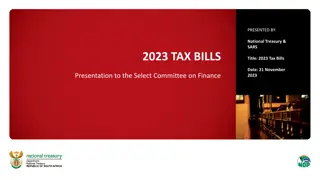
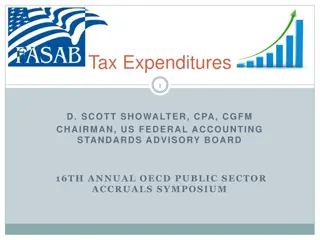

![Town of [Town Name] Real Estate Tax Rates and FY 2024 Budget Summary](/thumb/62211/town-of-town-name-real-estate-tax-rates-and-fy-2024-budget-summary.jpg)
